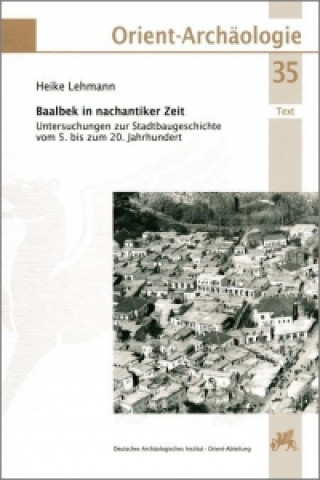
Delivery
Shopping guide





Doesn't suit? No problem! You can return within 30 days
 Gift voucher
any value
Gift voucher
any value
You won't go wrong with a gift voucher. The gift recipient can choose anything from our offer.
Lehmann, H: Baalbek in nachantiker Zeit
 Arabic
Arabic
 175 b
175 b
30-day return policy


Die Weltkulturerbestätte von Baalbek im Libanon gehört zu den ältesten kontinuierlich besiedelten Städten der Welt. Im Zentrum steht das monumentale römische Jupiterheiligtum, das in byzantinischer Zeit christianisiert und im islamischen Mittelalter zur Zitadelle ausgebaut wurde. In allen nachantiken Epochen wurde stets ökonomisch die ältere Bausubstanz in neue Bauvorhaben einbezogen. Größere Veränderungen fanden im Zuge der Christianisierung [4.-6. Jh.] statt, als Tempel umgewidmet, Kirchen und Straßen neu gebaut wurden. Mit dem Bustan Nassif wurde ein komplettes mittelalterliches Stadtviertel mit Wohnhäusern in fünf Bautypen, Suq-Gassen und öffentlichen Gebäuden ausgegraben. Andere Umbauphasen waren schweren Erdbeben des 12. Jhs. und der Mongoleninvasion des 13. Jhs. geschuldet. Die mittelalterliche Stadt war einerseits ein reicher Handelsplatz, andererseits ein wichtiges geistig-religiöses Zentrum. Die zweite Blütezeit im 19. Jh. hängt mit den "Tanzimat"-Reformen im Osmanischen Reich zusammen und spiegelt sich u.a. in Zentralhallenhäusern im christlichen Teil der Stadt und einer Bauverdichtung in der muslimischen Altstadt. The World Heritage site of Baalbek in Lebanon is amongst the oldest cities of the world with a continuous occupation. In its centre there is the monumental Roman sanctuary of Jupiter which had been Christianised in Byzantine times and turned into a citadel in the Islamic Middle Ages. In all post-Antique periods earlier building structures were economically included into new building measures. Major alterations occurred in the time of Christianisation [4th to 6th century], when temples were re-dedicated and churches and roads newly built. With the Bustan Nassif an entire Medieval city quarter has been excavated including its residential buildings of five different types, its souq lanes, and public buildings. Other rebuilding phases were owed to serious earthquakes of the 12th and Mongolian invasions of the 13th century. The Medieval city was both a rich commercial town and an important spiritual and religious centre. Its second heyday in the 19th century was connected to the "Tanzimat" reforms reorganising the Osman Empire and is reflected e.g. by houses with a central hall in the Christian quarter and redensification in the historic Muslim city centre.
About the book
 Arabic
Arabic




 How to shop
How to shop
















